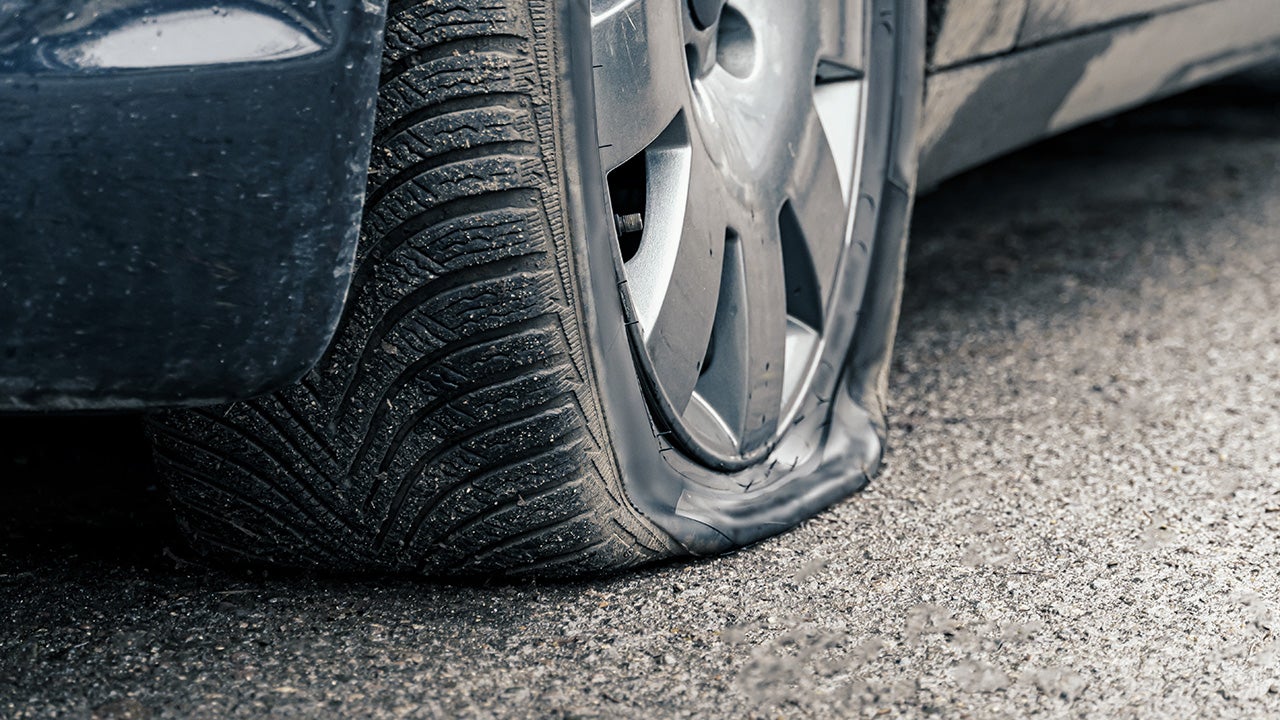Having a flat tire is nobody’s idea of fun, but it can happen any time you’re in your car. Flat tires cost money, cause aggravation and can be dangerous, especially if you’re driving on the highway. Keeping your tires well-maintained is an important part of car ownership, including monitoring them to ensure that they are not under- or over-inflated, and purchasing new tires when your old ones wear down. Keeping your tires in good condition makes accidents less likely—which means there is less chance you’ll need to file a claim on your car insurance policy, potentially leading to higher premiums. Bankrate’s guide to flat tires helps you understand what to do if you have a flat, and how to avoid them to save time, money and frustration.
Flat tire statistics
Even with proper care, you may experience a flat tire from time to time. Sharp objects in the road may pierce a tire, or you may be the victim of vandalism, for example. Consider the following flat tire statistics, which indicate that flat tires are more common than you might have thought:
- There are roughly 220 million flat tires annually in the U.S., equating to roughly seven every second. (Tiregrades)
- There were 562 motor vehicle traffic fatalities in 2022 in tire related crashes. (National Highway Traffic Safety Administration – NHTSA)
- Data from Consumer Reports indicates that only about 10 percent of new cars come with a full-sized spare. Roughly 50 percent have a temporary spare, and the rest come with a sealant kit, run-flat tire or nothing at all. (Consumer Reports)
- Underinflated tires increase the risk of a blowout by 300 percent. (Tiregrades)
- On an annual basis, an estimated 11,000 accidents are caused by bad tires, resulting in roughly 600 fatalities. (NHTSA)
- Only 42.2 percent of drivers are confident they can change a flat tire, while more than 20 percent have no idea how to handle this task. (NBC News)
- The NHTSA ruled in 2007 that all new vehicles must be equipped with a tire pressure monitoring system that would warn drivers when their tires are 25 percent or more underinflated. (NTSB)
What causes a flat tire?
You might assume that flat tires on the highway are only caused by punctures from road debris or sharp objects. But in reality, many variables can cause a flat tire. Here are some of the most common causes of flat tires:
- Overinflated tires: A tire with too much air in it is at risk of internal damage and possible leakage. It’s a good idea to use a tire gauge to ensure you are only filling your tire up to the maximum recommended pounds per square inch (PSI), and never more.
- Road debris: This common cause of flat tires can happen to anyone. You may drive over a discarded nail, broken glass or construction debris that isn’t visible to you in the driver’s seat, and find yourself with either a slow leak or puncture.
- Valve damage: Your tires valves are easily damaged, which can lead to a flat tire. Be sure to treat them gently when you are installing or refilling your tires with air.
- Temperature: Both very hot or bitterly cold temperatures are bad for tires. In cold weather, the tire contracts slightly, which can result in leakage. Hot weather, meanwhile, causes an expansion of the rubber, possibly leading to leaks or bursts.
- Vandalism: Deliberate slashing or puncturing is likely to result in a flat.
- Old tires: You’re more likely to experience a flat with older, worn tires than you are with tires that are on the newer side. It’s a good idea to monitor the tread and general look of your tires so you know when it’s time to replace them.
If you decide to change a flat tire yourself, there are a few tools you might want to have handy. Consider adding these to your car’s supplies before the need becomes urgent:
- Spare or donut tire: Although many car manufacturers now include a short-term donut tire with new cars—and some don’t include any spare at all—a few still include a full-size spare tire. It is usually located in the trunk or under the vehicle. If your car does not have a spare tire of some kind, it may be a good idea to purchase one in the event you have a flat.
- Car jack: These essential tools lift the car high enough that you are able to remove and replace the tire. Some cars come with a jack. It can be helpful to know ahead of time whether your car does have one or if you need to purchase it separately. Many vehicles include a flat plastic area under the bottom of the car where the jack fits when in use, to give you the best leverage for the task.
- Lug wrench: Tires are normally attached to the car using lug nuts and bolts. A lug wrench is the tool you’ll need to loosen and remove them to change your tire.
- Safety road reflectors: Although your best bet when changing a tire is to be off the road completely, this may not always be possible. In that event, safety reflectors or flares are vital to protect you from oncoming traffic. You may also want to invest in an orange safety vest to make it even easier for drivers to see you.
- Pressure gauge: Every driver should have a small pressure gauge that they can use to test the pressure (PSI, or pounds-per-square-inch) of their car’s tires. When changing your tire, it’s a good idea to check the pressure once the new tire is installed. You can find the recommended PSI on the side of the spare tire or on the label on the car’s door frame.
Tips for changing a flat tire
So what should you do if you have a flat tire and wish to change it yourself? Here are some action steps from tire manufacturer Bridgestone that can help you through the process:
- Be sure you’re in a safe location, out of the flow of traffic. Turn on your hazard lights to alert other drivers.
- Apply your parking brake and insert wheel wedges in front of or behind tires so the car can’t roll.
- Remove hubcap or wheel cover, if you have one. You will need a lug wrench for this.
- Place your jack under the vehicle, alongside the flat tire. Some vehicles have a plastic base under the car where you can place the jack. Raise the car using the jack.
- Unscrew lug nuts and remove the flat tire.
- Place the spare on the hub, lining up the rim with the lug bolts. Push gently until you can see the lug bolts through the rim.
- Tighten lug nuts by hand.
- Lower the car, and tighten the lug nuts again using the lug wrench.
What if I don’t have a spare tire?
As we noted above, not all cars come with a spare tire. If your vehicle does not have one, there are still steps you can take to get back on the road again after a flat tire. Consider the following ways you can be prepared:
- Fix-a-flat spray: Fix-a-flat spray could help you plug a tire leak quickly. After identifying the leak, move your car so the leaking spot is in the 6 o’clock position, then dispense the entire can of sealant on the leak. Keep in mind that this is a temporary repair and you should only use it to safely drive to an auto body shop.
- Car tire repair kit: Having a car tire repair kit in your car might come in handy if you get a flat. While these kits don’t usually provide a permanent fix, they often include a patch that can be adhered to the leak to slow the process.
- Tire plug kit: With a tire plug kit, you can stick a plug in the hole that is leaking. However, you might have to remove the tire in order to use the plug, depending on where the leak is located. Plugged tires can be driven on for roughly 10 miles (in most cases), so you still need to get the tire replaced as soon as possible.
- Switch to run-flat tires: If you don’t feel comfortable changing a flat tire yourself or don’t have the tools, consider upgrading your tires to run-flats. As the name suggests, these tires are designed to allow you to continue driving for a short distance after getting a flat. It’s not a permanent solution, but it does not require any work on your end.
- Call roadside assistance: Roadside assistance can provide basic vehicle repairs and towing, including flat tire changes, through your insurance company or a third-party provider such as AAA. If you’re interested in purchasing a roadside assistance plan, it’s a good idea to get multiple quotes to see which one is the cheapest option. You should also pay attention to the benefits you receive with each plan, as every roadside assistance package offers different services, maximum towing mileages and availability. Keep in mind that many insurance companies count the use of roadside assistance as a claim.
Does car insurance cover a flat tire?
Car insurance will sometimes cover a flat tire, but it depends on the specific situation. For example, if your car was vandalized and someone slashed the tires, the comprehensive portion of your car insurance policy would typically pay to replace the tires (minus your deductible). In the same way, your collision coverage could help pay for damage to your tires that occurs during an accident. However, car insurance does not pay for new tires if you got a flat due to road debris, temperatures or general wear and tear.
If you have roadside assistance as an endorsement on your insurance, it might offer support for tire-related issues, such as sending a technician to change a flat tire or provide towing services if the tire cannot be replaced on-site. However, it’s important to note that while this service can help get you back on the road, it does not typically cover the cost of a new tire. Consulting with your insurance provider can clarify what your policy covers and whether additional protections, like roadside assistance, may be useful.
How to prevent a flat tire
For any car, flat tires are not entirely preventable, but there are easy ways to lower your risk of getting a flat or blowing a tire while driving. Here are a few tips:
- Check tire pressure: Keeping an eye on your tire pressure is an excellent way to avoid flats. If you notice a tire that is looking low, use a tire pressure gauge to check the pressure. In general, it’s a good idea to check your tire pressure every few weeks, and always before going on a long road trip.
- Avoid construction areas: You might be more likely to get a flat tire when driving through a construction area, as nails, metal, staples and other sharp objects can get left on the road and puncture tires. When you can, consider avoiding driving through construction zones, and if it’s unavoidable, proceed with caution and look out for obvious hazards.
- Park in a garage: To avoid flat tires, opt for parking garages rather than street parking when possible. It might reduce the risk of vandalism where your tires could get slashed.
- Replace tires as needed: Although tires can be expensive, it’s important to replace your tires as needed to avoid flats. Most mechanics recommend getting a new set of tires every six to 10 years, or more frequently, depending on how often you drive. If you avoid replacing your tires, it could increase the likelihood of a flat and a tire-related accident.
Frequently asked questions
Read the full article here






